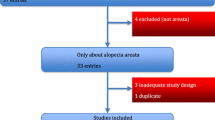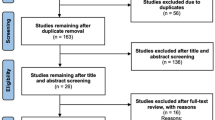Abstract
Alopecia areata is an unpredictable hair-loss condition. As there is no cure for alopecia areata and no effective conventional therapy, a substantial number of alopecia areata patients resort to complementary and alternative medical remedies and therapies (CAM). This review on the application of CAM in alopecia areata addresses two pertinent aspects. First, it provides a current overview of the published medical literature on CAM used in alopecia areata, and alopecia areata-related studies. Second, it presents a thorough assessment of the considerations and limitations of the use of CAM for the treatment of alopecia areata.
A systematic MEDLINE search yielded 13 studies of the clinical use of CAM in the management of alopecia areata, all belonging to one of the five main categories of CAM. Methodological quality was analyzed using objective assessment scores (Wilson and Lawrence scores). Unfortunately, no study was of sufficient internal validity to provide robust evidence of the benefit of CAM. This might be attributable to several specific disease characteristics of alopecia areata, which require an especially solid trial design to properly assess the therapeutic effects of CAM. The review concludes with some recommendations for improving the quality of trials incorporating CAM in the treatment of alopecia areata


Similar content being viewed by others
References
Sehgal VN, Jain S. Alopecia areata: clinical perspective and an insight into pathogenesis. J Dermatol 2003 Apr; 30 (4): 271–89
Sinclair RD. Alopecia areata. In: Sinclair RD, Banfield C, Dawber R, editors. Handbook of diseases of the hair and scalp. Oxford: Blackwell Science Ltd, 1999: 75–84
Madani S, Shapiro J. Alopecia areata update. J Am Acad Dermatol 2000 Apr; 42 (4): 549–66; quiz 67-70
Price VH. Treatment of hair loss. New Engl J Med 1999 Sep 23; 341 (13): 964–73
Green J, Sinclair RD. Genetics of alopecia areata. Australas J Dermatol 2000 Nov; 41 (4): 213–8
Wasserman D, Guzman-Sanchez DA, Scott K, et al. Alopecia areata. Int J Dermatol 2007 Feb; 46 (2): 121–31
McMichael A. Impact of hair disorders and pigment disorders on quality of life. In: Rajagopalan R, Sherertz E, Anderson R, editors. Care management of skin diseases, life quality and economic impact. New York: Marcel Dekker Inc., 1998: 207–23
Levin C, Maibach H. Exploration of “alternative” and “natural” drugs in dermatology. Arch Dermatol 2002 Feb; 138 (2): 207–11
Hairweb Forum. The support site for people with hair problems in The Netherlands and Belgium [online; in Dutch]. Available from URL: http://www.haarweb.nl/forum/index.php [Accessed 2007 Aug 1]
Russo J. Home remedies to treat alopecia areata: the CAM report. Complementary and alternative medicine: fair, balanced, and to the point 2007 [online]. Available from URL: http://www.thecamreport.com/?p=744 [Accessed 2008 Jan 1]
Shapiro J, Kalish RS, Mallory S, et al. Medical questions and answers: alternative treatments. 17th Annual National Alopecia Areata Foundation International Conference; 2002 Jul 11-14; St. Louis (MO)
Eisenberg DM, Davis RB, Ettner SL, et al. Trends in alternative medicine use in the United States, 1990-1997: results of a follow-up national survey. JAMA 1998 Nov 11; 280 (18): 1569–75
National Center for Complementary and Alternative Medicine. What is CAM? 2007 [online]. Available from URL: http://nccam.nih.gov/health/whatiscam/ [Accessed 2007 Aug 1]
Wilson S, Maddison T, Roberts L, et al. Systematic review: the effectiveness of hypnotherapy in the management of irritable bowel syndrome. Aliment Pharmacol Ther 2006 Sep 1; 24 (5): 769–80
Canadian Task Force on the PeriodicHealth Examination. The periodic health examination 2: 1987 update. CMAJ 1988 Apr 1; 138 (7): 618–26
Lawrence RS, Mickalide AD. Preventive services in clinical practice: designing the periodic health examination. JAMA 1987 Apr 24; 257 (16): 2205–7
Itamura R. Effect of homeopathic treatment of 60 Japanese patients with chronic skin disease. Complement Ther Med 2007 Jun; 15 (2): 115–20
Harrison PV, Stepanek P. Hypnotherapy for alopecia areata. Br J Dermatol 1991 May; 124 (5): 509–10
Willemsen R, Vanderlinden J, Deconinck A, et al. Hypnotherapeutic management of alopecia areata. J Am Acad Dermatol 2006 Aug; 55 (2): 233–7
Teshima H, Sogawa H, Mizobe K, et al. Application of psychoimmunotherapy in patients with alopecia universalis. Psychother Psychosom 1991; 56 (4): 235–41
Hay IC, Jamieson M, Ormerod AD. Randomized trial of aromatherapy: successful treatment for alopecia areata. Arch Dermatol 1998 Nov; 134 (11): 1349–52
Sharquie KE, Al-Obaidi HK. Onion juice (Allium cepa L.), a new topical treatment for alopecia areata. J Dermatol 2002 Jun; 29 (6): 343–6
Hajhydari Z, Jamshidi M, Akbari J, et al. Combination of topical garlic gel and betamethasone valerate cream in the treatment of localized alopecia areata: a double-blind randomized controlled study. Indian J Dermatol Venereol Leprol 2007 Jan-Feb; 73 (1): 29–32
Much T. Treatment of alopecia areata with vitamin A acid [in German]. Zeitschrift fur Hautkrankheiten 1976 Dec 1; 51 (23): 993–8
Xie S. Three typical dermatological cases treated by Dr. Li Yueping. J Tradit Chin Med 2005 Jun; 25 (2): 129–31
Höfer W, Honemann W, Sierke ML. Treatment of alopecia areata with segmental massage [in German]. Dermatol Monatsschr 1969; 155 (9): 724–9
Putt SC, Weinstein L, Dzindolet MT. A case study: massage, relaxation, and reward for treatment of alopecia areata. Psychol Rep 1994 Jun; 74 (3 Pt 2): 1315–8
Ge S. Treatment of alopecia areata with acupuncture. J Tradit Chin Med 1990 Sep; 10 (3): 199–200
Anninos P, Karpouzis A, Kotini A, et al. Exogenous magnetic stimulation in therapeutic management of universalis alopecia areata. Gazzetta Medica Italiana-Archivio per le Scienze Mediche 2004; 163: 281–4
Anninos PA, Karpouzis A, Kotini A, et al. Magnetoencephalography measurements and exogenousmagnetic stimulation in therapeutic management of universalis alopecia areata: about three cases. 12th International Conference on Mechanics and Medicine and Biology; 2002 Sep 9-13; Lemnos
Kirby BJ. Safety of homeopathic products. J R Soc Med 2002 May; 95 (5): 221–2
Kalish RS. Comment and author reply on: randomized trial of aromatherapy: successful treatment for alopecia areata. Arch Dermatol 1999 May; 135 (5): 602–3
Esfandiari A, Kelly AP. The effects of tea polyphenolic compounds on hair loss among rodents. J Natl Med Assoc 2005 Aug; 97 (8): 1165–9
Matsuda H, Yamazaki M, Asanuma Y, et al. Promotion of hair growth by ginseng radix on cultured mouse vibrissal hair follicles. Phytother Res 2003 Aug; 17 (7): 797–800
Ogawa H, Ogura K, Ishigouoka H, et al. Effect of plantworm extract on mouse hair growth. J Dermatol 1986 Apr; 13 (2): 126–31
Rho SS, Park SJ, Hwang SL, et al. The hair growth promoting effect of Asiasari radix extract and its molecular regulation. J Dermatol Sci 2005 May; 38 (2): 89–97
Roh SS, Kim CD, Lee MH, et al. The hair growth promoting effect of Sophora flavescens extract and its molecular regulation. J Dermatol Sci 2002 Oct; 30 (1): 43–9
Adhirajan N, Ravi Kumar T, Shanmugasundaram N, et al. In vivo and in vitro evaluation of hair growth potential of Hibiscus rosa-sinensis Linn. J Ethnopharmacol 2003 Oct; 88 (2-3): 235–9
Waters KC. Acupuncture for dermatologic disorders. Probl Vet Med 1992 Mar; 4 (1): 194–9
Kwon OS, Han JH, Yoo HG, et al. Human hair growth enhancement in vitro by green tea epigallocatechin-3-gallate (EGCG). Phytomedicine 2007 Aug; 14 (7-8): 551–5
Meidan VM, Touitou E. Treatments for androgenetic alopecia and alopecia areata: current options and future prospects. Drugs 2001; 61 (1): 53–69
Sundberg JP, Boggess D, Montagutelli X, et al. C3H/HeJ mouse model for alopecia areata. J Invest Dermatol 1995 May; 104 (5 Suppl.): 16S–7S
Michie HJ, Jahoda CA, Oliver RF, et al. The DEBR rat: an animal model of human alopecia areata. Br J Dermatol 1991 Aug; 125 (2): 94–100
Shapiro J, Sundberg JP, Bissonnette R, et al. Alopecia areata-like hair loss in C3H/HeJ mice and DEBR rats can be reversed using topical diphencyprone. J Investig Dermatol Symp Proc 1999 Dec; 4 (3): 239
Sterne JA, Egger M, Smith GD. Systematic reviews in health care: investigating and dealing with publication and other biases in meta-analysis. BMJ 2001 Jul 14; 323 (7304): 101–5
Walker SA, Rothman S. A statistical study and consideration of endocrine influences. J Invest Dermatol 1950 Jun; 14 (6): 403–13
Vestey JP, Savin JA. A trial of 1% minoxidil used topically for severe alopecia areata. Acta Derm Venereol 1986; 66 (2): 179–80
Tosti A, Bellavista S, Iorizzo M. Alopecia areata: a long term follow-up study of 191 patients. J Am Acad Dermatol 2006 Sep; 55 (3): 438–41
Singer AJ. Alternative medicine: why should we care? Acad Emerg Med 2001 Jan; 8 (1): 65–7
Sullivan R, Smith JE, Rowan NJ. Medicinal mushrooms and cancer therapy: translating a traditional practice into Western medicine. Perspect Biol Med 2006 Spring; 49 (2): 159–70
Begg C, Cho M, Eastwood S, et al. Improving the quality of reporting of randomized controlled trials: the CONSORT statement. JAMA 1996 Aug 28; 276 (8): 637–9
Fontanarosa PB, Lundberg GD. Alternative medicine meets science. JAMA 1998 Nov 11; 280 (18): 1618–9
Margolin A, Avants SK, Kleber HD. Investigating alternative medicine therapies in randomized controlled trials. JAMA 1998 Nov 11; 280 (18): 1626–8
Hull SM, Norris JF. Diphencyprone in the treatment of long-standing alopecia areata. Br J Dermatol 1988 Sep; 119 (3): 367–74
Derogatis LR. SCL-90: administration, scoring and procedures manual: I for the revised version. Baltimore (MD): Johns Hopkins University School of Medicine, Clinical Psychometrics Research Unit, 1977
Acknowledgments
No sources of funding were used to assist in the preparation of this review. The authors have no conflicts of interest that are directly relevant to the content of this review.
Author information
Authors and Affiliations
Corresponding author
Rights and permissions
About this article
Cite this article
van den Biggelaar, F.J.H.M., Smolders, J. & Jansen, J.F.A. Complementary and Alternative Medicine in Alopecia Areata. AM J Clin Dermatol 11, 11–20 (2010). https://doi.org/10.2165/11530040-000000000-00000
Published:
Issue Date:
DOI: https://doi.org/10.2165/11530040-000000000-00000




